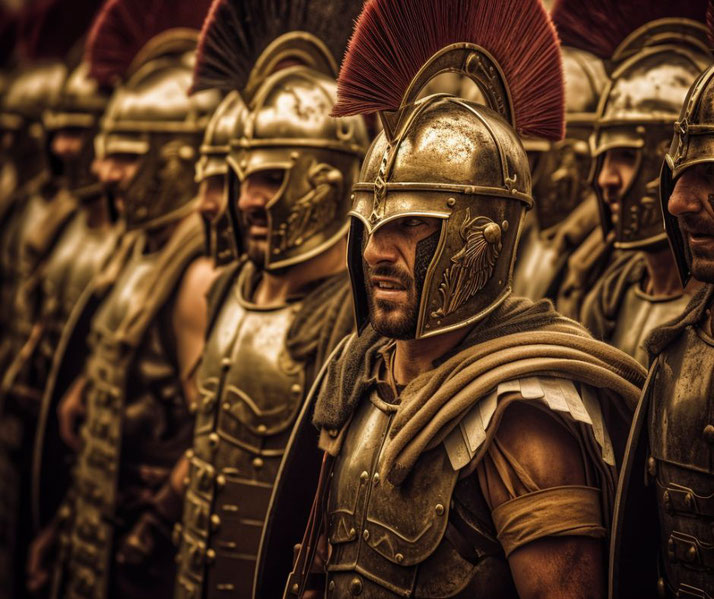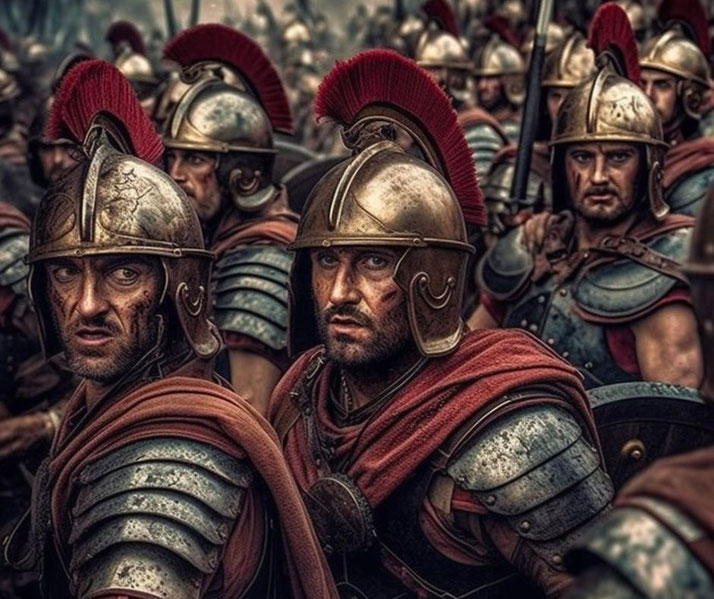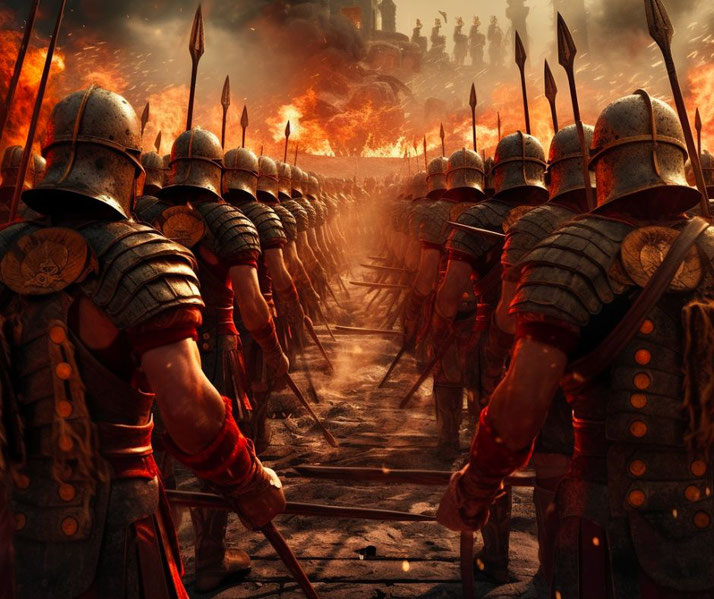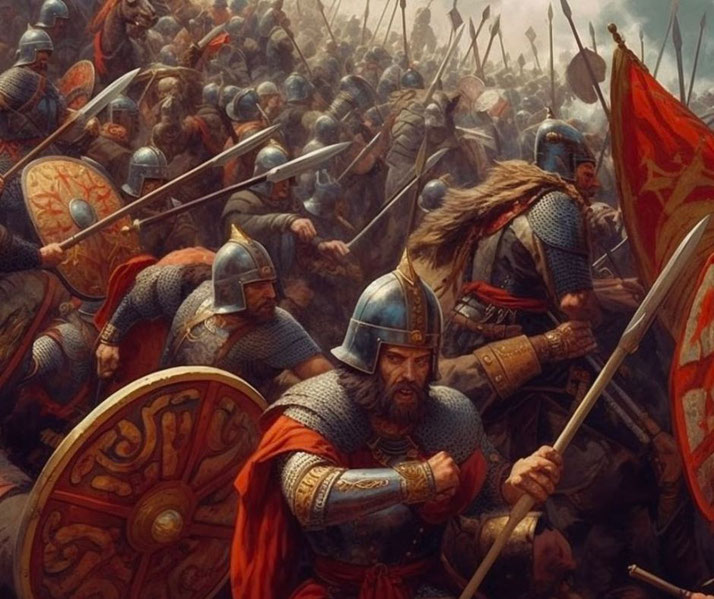How the Roman legions changed throughout their 1000-year history

From the heart of Italy arose an empire that would dominate the ancient world for over a thousand years, leaving an indelible mark on the course of history.
A key part of this empire's power and endurance was its military, and at the core of that military were the Roman legions. These formations of heavy infantry, named after the Latin word 'legio' meaning 'levy of soldiers', were more than just the backbone of Rome's military might.
They were a reflection of the Roman society, mirroring its evolution from a city-state to a vast empire, from a citizen militia to a professional army, and embodying Rome's spirit of resilience, discipline, and innovation.
The Roman legions were no static institution. They evolved over the centuries in response to external threats, internal conflicts, technological advancements, and societal changes, becoming ever more refined weapons of war.
Their evolution was neither linear nor uniform, shaped as it was by the varied challenges of different periods and regions.
Yet through these changes, they remained a powerful symbol of Roman authority and a crucial instrument of Roman statecraft.
What were the very first Roman armies like?
The early Roman military was heavily influenced by its neighbors and predecessors, especially the Etruscans to the north and the Greeks to the south.
The Etruscan influence is particularly significant, as Rome was under Etruscan rule during the late monarchy period (7th to 6th century BCE).
The early Roman army was likely composed of a levy, or 'legio', of citizens who could afford to arm themselves, drawn up into a phalanx in the Greek fashion.
This early 'legio' was not yet the legion as we know it, but it planted the seeds for its eventual formation.
This citizen militia was, like the Greek phalanx it emulated, a heavy infantry force. The soldiers, or 'hoplites', fought in a dense formation with large, round shields and long spears.
But while this formation was effective in the flat and open terrain of Greece, it was less suited to the hilly and broken landscapes of central Italy.
Moreover, it relied on a degree of discipline and training that a citizen militia could not always provide.
As Rome began to expand and come into conflict with other peoples of Italy, it faced military challenges that its hoplite phalanx could not effectively meet.
The shortcomings of the phalanx became particularly apparent during Rome's early wars against its hill-dwelling neighbors such as the Samnites.
The limitations of the phalanx in maneuverability and flexibility on difficult terrain led to significant Roman defeats, forcing a rethinking of Roman military structure.

The birth of the 'maniple system'
The seeds of change had been sown during the challenging early conflicts of Rome, leading to a military transformation that saw the birth of the Roman legion as we know it.
The departure from the rigid Greek phalanx gave rise to the more flexible manipular system, characterized by its checkerboard deployment, versatility, and increased maneuverability, better suited for the varied terrain of the Italian Peninsula.
The basic unit of this early Roman legion was the 'maniple' or 'manipulus', which meant 'a handful'.
Each maniple consisted of 120 soldiers in the early manipular legions, and these maniples were deployed in a staggered pattern across three lines, hence the term 'manipular legion'.
The first line was made up of 'hastati', young and less experienced soldiers; the second of 'principes', the prime soldiers in their 30s; and the final line of 'triarii', the most veteran soldiers.
This deployment allowed the Roman army to be more fluid and responsive on the battlefield, able to plug gaps, perform complex maneuvers, and maintain cohesion in the face of enemy attacks.
The equipment of the soldiers also evolved. The legionaries were now more uniformly armed, with a short stabbing sword, the 'gladius', and two 'pila', heavy javelins designed to disrupt enemy formations.
The manipular legion was not just a tactical formation, but a social organism. The soldiers were citizens who provided their own equipment and fought for their city and their homes.
The formation reflected the social order, with wealthier citizens serving as cavalry or in the front ranks, where the armor and weapons were more expensive but the glory greater, and poorer citizens in the lighter-armed rear ranks.
This link between military service and citizenship was a crucial feature of the Roman Republic, reinforcing social bonds and civic virtues.
But the manipular legion also had its limitations. Its formation required a high degree of discipline and skill to maintain in the heat of battle.
The self-equipped nature of the soldiers meant that the quality of arms and armor could vary greatly.
And as Rome's ambitions grew, the seasonal, citizen-based army struggled to cope with the demands of prolonged wars and distant campaigns.
The early manipular legions played a crucial role in Rome's wars against its neighbors, including the Samnite Wars of the 4th and early 3rd centuries BCE.
These wars were a key testing ground for the new Roman military system, pushing it to evolve and refine itself further. It was during these wars that Rome's characteristic way of war - combining tactical flexibility, relentless aggression, and strategic tenacity - began to take shape.
The Marian reforms
The manipular system was tested to its limits during the Punic Wars against Carthage in the 3rd and 2nd centuries BCE.
The Second Punic War, in particular, was a trial by fire for the Roman military. The brilliant Carthaginian general Hannibal won several spectacular victories against Rome, but the flexibility and resilience of the manipular legion helped Rome to endure these setbacks and ultimately prevail.
The war demonstrated both the strengths and weaknesses of the manipular legion, setting the stage for further reforms that would create the professional legion of the Roman Empire.
In the closing decades of the second century BCE, Rome's reach had extended far beyond the Italian Peninsula.
Conquests in Spain, North Africa, and the eastern Mediterranean had transformed Rome from a regional power into a burgeoning empire.
This expansion presented new logistical and strategic challenges for Rome's military.
Enter Gaius Marius, a celebrated general and statesman. Serving as consul an unprecedented seven times, Marius brought about significant reforms, around 107 BCE, to the Roman military system, forever changing the structure and organization of the Roman legions.
Marius' reforms eliminated the property requirements for military service, allowing the state to draw upon a much larger pool of manpower.
This change opened up the legions to the poorer citizens, who were now provided with state-funded arms and armor.
By breaking down the socio-economic barriers to service, Marius effectively democratized the legions and transformed them into a professional standing army, available for deployment at any time and any place within the vast Roman territories.
Marius also standardized training, weapons, and equipment among the legions. The distinct manipular units—hastati, principes, and triarii—were replaced with a single type of heavy infantryman, known as the 'legionary', who was equipped with the same armor, weapons, and shields.
The maniple was replaced with the larger cohort, consisting of six centuries, or 480 men, becoming the standard tactical unit of the Roman legions.
The introduction of the eagle, or 'aquila', as the sole standard of the legion is another lasting legacy of Marius.
This practice boosted morale and loyalty among the soldiers, with the eagle becoming a symbol of Roman military might and unity.
The Marian Reforms had far-reaching implications for Roman society. They provided opportunities for glory and wealth to a broader section of Roman citizens, but they also fueled social and political tensions, as generals like Marius himself, and later Julius Caesar, used their armies for political leverage.
Moreover, by professionalizing the army, Marius helped to create a military machine that could project Rome's power across the known world, paving the way for the expansion of the Roman Empire.

The dawn of the imperial legions
With the advent of the Roman Empire following the death of Julius Caesar and the rise of his adopted heir Augustus, the Roman legions underwent yet another significant transformation.
The political turmoil of the late Republic, characterized by civil wars and power struggles, had revealed the dangers of legions loyal to their generals rather than the state.
Augustus sought to address these issues as he consolidated his power and established the principate, the first phase of the Roman Empire.
Augustus, also known as the 'father of the Roman army', cemented the transition to a professional military that had begun with the Marian reforms.
He formalized the terms of service for soldiers, setting a limit of twenty years with a promise of land or a pension upon discharge.
This offered an attractive career path for poorer citizens and cemented the loyalty of the soldiers to the state and the emperor who paid their wages.
The organization of the legions also saw further standardization. Each legion, typically consisting of around 5,000 men, was subdivided into ten cohorts, with the first cohort being double the size of the remaining nine.
Each cohort was made up of six centuries, led by a centurion. This structure remained consistent across all the legions, allowing for interchangeable parts in a vast, empire-wide military system.
The Imperial legion was not just a fighting force; it was also a tool of Romanization. Wherever legions were stationed, they brought with them the Latin language and Roman culture, customs, and law.
The veterans, upon their discharge, often settled in the provinces, further spreading Roman influence and serving as a stabilizing force.
Augustus also established the Praetorian Guard, a special force for the protection of the emperor, and the auxilia, non-citizen troops who provided light infantry, cavalry, and specialist skills that the heavy infantry-focused legions lacked.
After 25 years of service, these auxiliary soldiers were granted Roman citizenship, providing a path to social mobility for provincial subjects and ensuring their loyalty to Rome.
The Imperial legions were the engine of Rome's power during the Pax Romana, a period of relative peace and stability across the Empire lasting from 27 BCE to 180 CE.
They guarded the borders, maintained internal security, built roads and forts, and participated in the occasional wars of expansion that continued to push the boundaries of the Empire.

The fragmentation of the late Roman legions
As the Roman Empire moved into its later stages, particularly from the 3rd century CE onwards, it faced a range of new challenges including internal political instability, economic pressures, and invasions from Germanic tribes.
These pressures led to further significant changes in the Roman legions, aimed at responding to the increasingly defensive needs of the Empire.
Under Emperor Diocletian and later Constantine the Great, the Roman military was restructured to meet these challenges.
The large, multi-purpose legions that had characterized the earlier Roman army were broken up into smaller, more flexible units that could respond quickly to threats along the vast frontier.
The 'comitatenses' were mobile units that could be rapidly deployed to crisis points within the Empire, while the 'limitanei' or 'border troops' guarded the frontiers.
This period also saw a greater reliance on cavalry and lighter infantry, reflecting the influence of the Germanic and other 'barbarian' peoples who were increasingly being recruited into the Roman forces.
This was a significant departure from the heavy infantry focus of the earlier Roman legions.
The concept of citizenship also evolved during this period. In 212 CE, Emperor Caracalla granted Roman citizenship to all free men within the Empire, effectively erasing the distinction between the citizens and non-citizens in the auxilia.
This reflected the increasingly multicultural character of the late Roman Empire, but it also marked a further departure from the citizen-soldier ideal of the Roman Republic.
These changes allowed the Roman Empire to endure for another two centuries in the face of numerous challenges.
However, they also reflected a military system under strain, increasingly reliant on foreign recruits, and stretched thin across a vast frontier.
The late Roman legions were a far cry from the citizen armies of the Roman Republic or the professional legions of the early Empire.
Yet they were still recognizably Roman, embodying the pragmatism, adaptability, and resilience that had been the hallmarks of Rome's military system throughout its history.

The slow decline of the empire and its legions
As the Roman Empire entered its final stages, especially in the Western Empire, the legions that had once marched victorious across Europe, Asia, and Africa faced a series of insurmountable challenges.
Political instability and economic decline had weakened the Empire internally, making it difficult to maintain the same level of military organization and discipline that had characterized the legions in their prime.
There was also a rising trend of 'barbarization' within the legions, as the Roman military became increasingly reliant on Germanic and other 'barbarian' recruits to fill their ranks.
The legions' tactics, weaponry, and even composition evolved during these waning centuries, partially influenced by the very 'barbarian' forces they frequently battled.
The heavy infantry that had once been the core of the Roman military might gave way to a more cavalry-oriented force, a transformation that was reflective of the changes in warfare during late antiquity.
The symbolic end of the Roman legions came with the fall of the Western Roman Empire in 476 CE, when the last Roman emperor, Romulus Augustus, was deposed by the Germanic king Odoacer.
This marked the end of a unified political entity known as 'Rome' in the west, and by extension, the end of the Roman legions.
However, the Eastern Roman Empire, also known as the Byzantine Empire, continued to survive, maintaining some semblance of the Roman military tradition.
In the Byzantine army, elements of the Roman legionary system continued, but these units were increasingly supplemented or even replaced by other forms of organization, such as the 'thematic' system or the elite 'tagmata'.
The Byzantine military incorporated many elements from its Roman past, but it was also significantly influenced by its own unique challenges and circumstances.
What do you need help with?
Download ready-to-use digital learning resources
Copyright © History Skills 2014-2024.
Contact via email
With the exception of links to external sites, some historical sources and extracts from specific publications, all content on this website is copyrighted by History Skills. This content may not be copied, republished or redistributed without written permission from the website creator. Please use the Contact page to obtain relevant permission.





